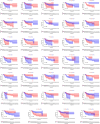Exploring gene biomarkers and targeted drugs for ferroptosis and cuproptosis in osteosarcoma: A bioinformatic approach
- PMID: 38546286
- PMCID: PMC12069744
- DOI: 10.1002/tox.24250
Exploring gene biomarkers and targeted drugs for ferroptosis and cuproptosis in osteosarcoma: A bioinformatic approach
Abstract
Osteosarcoma predominantly affects adolescents and young adults and is characterized as a malignant bone tumor. In recent decades, substantial advancements have been achieved in both diagnosing and treating osteosarcoma. Resulting in enhanced survival rates. Despite these advancements, the intricate relationship between ferroptosis and cuproptosis genes in osteosarcoma remains inadequately understood. Leveraging TARGET and GEO datasets, we conducted Cox regression analysis to select prognostic genes from a cohort of 71 candidates. Subsequently, a novel prognostic model was engineered using the LASSO algorithm. Kaplan-Meier analysis demonstrated that patients stratified as low risk had a substantially better prognosis compared with their high-risk counterparts. The model's validity was corroborated by the area under the receiver operating characteristic (ROC) curve. Additionally, we ascertained independent prognostic indicators, including clinical presentation, metastatic status, and risk scores, and crafted a clinical scoring system via nomograms. The tumor immune microenvironment was appraised through ESTIMATE, CIBERSORT, and single-sample gene set enrichment analysis. Gene expression within the model was authenticated through PCR validation. The prognostic model, refined by Cox regression and the LASSO algorithm, comprised two risk genes. Kaplan-Meier curves confirmed a significantly improved prognosis for the low-risk group in contrast to those identified as high-risk. For the training set, the ROC area under the curve (AUC) values stood at 0.636, 0.695, and 0.729 for the 1-, 3-, and 5-year checkpoints, respectively. Although validation set AUCs were 0.738, 0.668, and 0.596, respectively. Immune microenvironmental analysis indicated potential immune deficiencies in high-risk patients. Additionally, sensitivity to three small molecule drugs was investigated in the high-risk cohort, informing potential immunotherapeutic strategies for osteosarcoma. PCR analysis showed increased mRNA levels of the genes FDX1 and SQLE in osteosarcoma tissues. This study elucidates the interaction of ferroptosis and cuproptosis genes in osteosarcoma and paves the way for more targeted immunotherapy.
Keywords: cuproptosis; ferroptosis; osteosarcoma; prognostic marker.
© 2024 The Authors. Environmental Toxicology published by Wiley Periodicals LLC.
Conflict of interest statement
The authors declare that they have no competing interests.
Figures









Similar articles
-
Ferroptosis-related gene signature associates with immunity and predicts prognosis accurately in patients with osteosarcoma.Cancer Sci. 2021 Nov;112(11):4785-4798. doi: 10.1111/cas.15131. Epub 2021 Sep 21. Cancer Sci. 2021. PMID: 34506683 Free PMC article.
-
Develop a Novel Signature to Predict the Survival and Affect the Immune Microenvironment of Osteosarcoma Patients: Anoikis-Related Genes.J Immunol Res. 2024 Mar 27;2024:6595252. doi: 10.1155/2024/6595252. eCollection 2024. J Immunol Res. 2024. PMID: 39431237 Free PMC article.
-
Prognostic model of osteosarcoma based on telomere-related genes and analysis of immune characteristics.Int Immunopharmacol. 2025 Apr 4;151:114198. doi: 10.1016/j.intimp.2025.114198. Epub 2025 Feb 20. Int Immunopharmacol. 2025. PMID: 39983416
-
Construction and validation of a novel cuproptosis-mitochondrion prognostic model related with tumor immunity in osteosarcoma.PLoS One. 2023 Jul 5;18(7):e0288180. doi: 10.1371/journal.pone.0288180. eCollection 2023. PLoS One. 2023. PMID: 37405988 Free PMC article.
-
Ferroptosis-related lncRNAs guiding osteosarcoma prognosis and immune microenvironment.J Orthop Surg Res. 2023 Oct 19;18(1):787. doi: 10.1186/s13018-023-04286-3. J Orthop Surg Res. 2023. PMID: 37858131 Free PMC article.
Cited by
-
Ubiquitination in lipid metabolism reprogramming: implications for pediatric solid tumors.Front Immunol. 2025 Apr 30;16:1554311. doi: 10.3389/fimmu.2025.1554311. eCollection 2025. Front Immunol. 2025. PMID: 40370434 Free PMC article. Review.
-
Cross-talk between cuproptosis and ferroptosis to identify immune landscape in cervical cancer for mRNA vaccines development.Eur J Med Res. 2024 Dec 19;29(1):602. doi: 10.1186/s40001-024-02191-x. Eur J Med Res. 2024. PMID: 39696618 Free PMC article.
References
-
- Chen C, Xie L, Ren T, Huang Y, Xu J, Guo W. Immunotherapy for osteosarcoma: fundamental mechanism, rationale, and recent breakthroughs. Cancer Lett. 2021;500:1‐10. - PubMed
-
- Wen RJ, Dong X, Zhuang HW, et al. Baicalin induces ferroptosis in osteosarcomas through a novel Nrf2/xCT/GPX4 regulatory axis. Phytomedicine. 2023;116:154881. - PubMed
-
- Cen D, Brayton D, Shahandeh B, Meyskens FL Jr, Farmer PJ. Disulfiram facilitates intracellular Cu uptake and induces apoptosis in human melanoma cells. J Med Chem. 2004;47(27):6914‐6920. - PubMed
MeSH terms
Substances
LinkOut - more resources
Full Text Sources
Medical

